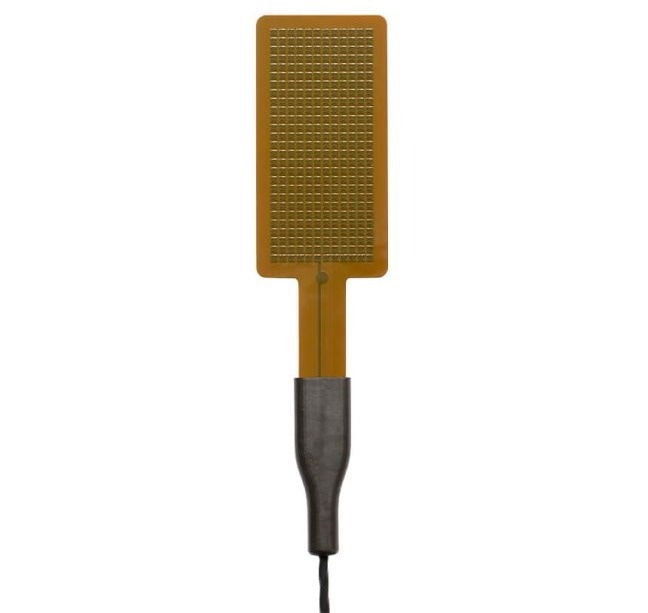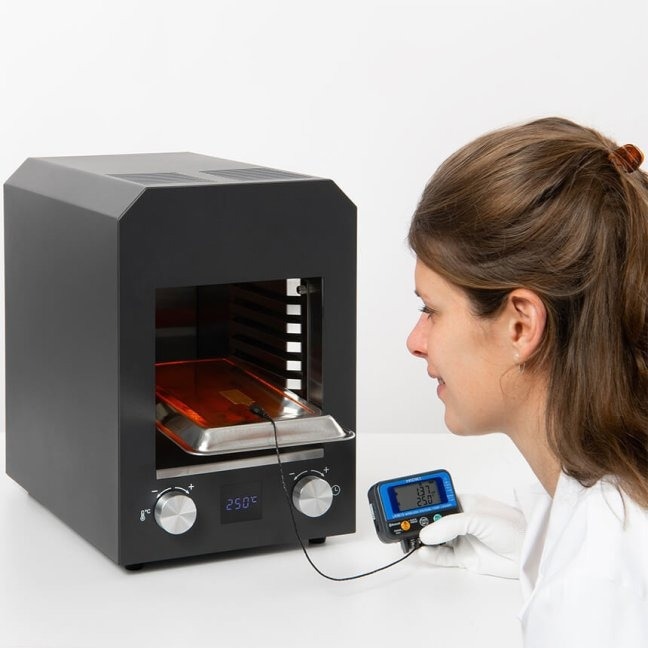The FHF06 foil heat flux sensor is the ideal solution for high-temperature heat flux measurements. This thin, flexible, and sensitive sensor can withstand temperatures from -70 °C to +250 °C, making it ideal for various applications. If high temperatures are not your concern, explore our FHF05 series heat flux sensors that can also be found on this website.
Specifications
Source: Hukseflux Thermal Sensors B.V.
| . |
. |
| Measurand |
heat flux, temperature |
| Outer dimensions foil with guard |
(25 x 50) x 10⁻³ m |
| Measurement range |
(-20 to +20) x 10³ W/m² |
| Temperature sensor |
type T thermocouple, IEC 60584-1:2013 class 2* |
| Thermal spreaders |
included |
| Rated bending radius |
≥ 7.5 x 10⁻³ m |
| Rated load on cable |
≤ 1.6 kg |
| Sensor thermal resistance |
12 x 10⁻⁴ K/(W/m²) |
| Sensor thickness |
0.38 x 10⁻³ m |
| Uncertainty of calibration |
± 5 % (k = 2) |
| Sensitivity (nominal) |
5 x 10⁻⁶ V/(W/m²) |
| Asymmetry |
< 2 % |
| Rated operating temperature range |
: |
| Continuous use** |
-70 to +250 °C |
| Cable |
-70 to +250 °C |
| Connection block |
-70 to +250 °C |
| Label at the end of the cable |
-40 to +120 °C |
| IP protection class |
IP67*** |
| Rated operating pressure range |
up to 25 bar |
| Standard cable length |
2 m |
| Options |
5 or 10 m cable length; separate cable; without cable**** |
| * |
temperature measurement uncertainty: ± 2.5 or 0.0075 × T °C. For details, refer to user manual. |
| ** |
when measuring at temperatures of -160 °C, contact Hukseflux. |
| *** |
sensor is not suitable for continuous exposure to water. |
| **** |
sensor foil only (without cable and connection block) may be used in vacuum. |
Options
- With 5 m or 10 m cable length
- Sensor foil only, without wiring, without connection block
- Separate cable in 2, 5, or 10 m lengths
- LI19 hand-held read-out unit/datalogger (NOTE: LI19 measures heat flux only)
Description
Heat Flux Measurement in High Temperature Environments
The FHF06 is a high-temperature foil heat flux sensor capable of handling temperatures up to 250 °C due to its glue-free all-polyimide design. Other members of the FHF family, the FHF05 series range, can be used up to 120 °C maximum, which makes the FHF06 heat flux sensor unique.

Image Credit: Hukseflux Thermal Sensors B.V.
The sensor is thin, flexible and versatile. FHF06 measures heat flux through the object in which it is incorporated or on which it is mounted in W/m².
The sensor in FHF06 is a thermopile. This thermopile measures the temperature difference across FHF06’s flexible body. A type T thermocouple is also integrated to provide a temperature measurement. The thermopile and thermocouple are passive sensors; they do not require power.
Multiple small thermal spreaders, which form a conductive layer covering the sensor, help reduce the thermal conductivity dependence of the measurement. With these incorporated spreaders, the sensitivity of FHF06 heat flux sensor is independent of its environment.
Heat Flux Sensor with Unique Features and Benefits
- Fast response time
- High-temperature resistance up to 250 °C continuous use
- Flexible (bending radius ≥7.5 x 10-³ m)
- Low thermal resistance
- Robustness, including a connection block for strain relief
- Integrated type T thermocouple
- IP protection class: IP67 (essential for outdoor applications)
- Integrated thermal spreaders for low thermal conductivity dependence
- Sensor foil only: may be used in vacuum

Image Credit: Hukseflux Thermal Sensors B.V.
Easy to Use Heat Flux Sensor
The FHF06 heat flux sensor is user-friendly and easily integrates into datalogging systems. Calculating heat flux in W/m² is straightforward: divide the FHF06 output (a small voltage) by its sensitivity. The sensitivity information is available on the FHF06 certificate and at the end of its cable for convenient reference.
A Heat Flux Sensor that is Robust and Stable
FHF06 heat flux sensors are highly durable and stable, featuring a connection block that doubles as strain relief and potted protective covers on both sides, ensuring moisture protection.
Additionally, FHF06 calibration adheres to international standards and is traceable. The factory calibration method aligns with the recommended practice outlined in ASTM C1130 - 21.

Image Credit: Hukseflux Thermal Sensors B.V.
Working with Heat Flux Sensors
The FHF06’s sensitivity to heat flux may vary from what is listed on its certificate when employed in high-temperature environments. For correcting this temperature dependence, see the user manual which can be found on the FHF06 product page on the Hukseflux.com website. For mounting, see our application note "how to install a heat flux sensor" that can also be found on the Hukseflux.com website.

Image Credit: Hukseflux Thermal Sensors B.V.
Suitable Electronics
The combination of heat flux and temperature measurement provides a complete view of a system’s thermal behavior. The output of a heat flux sensor is a millivolt signal. Heat flux sensors are frequently used in conjunction with thermocouples.
Hukseflux offers numerous preferred amplifications, data logging, and data visualization solutions.
Suggested Use
FHF06 heat flux sensors are commonly used in the following applications:
- Monitoring of plastics and composite molding
- Battery research; thermal runoff
- Analysis of industrial ovens